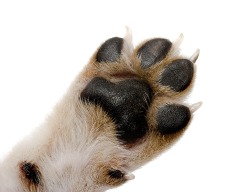An Improved Understanding of Canine Paw Anatomy May Help Get Injured Dogs Back On Their Feet
 The canine paw is vulnerable to injury, and paw wounds are common – particularly in working dogs. Unfortunately, a lack of detailed information about paw anatomy has historically hindered veterinarian’s ability to treat paw injuries effectively. Such wounds frequently require multiple surgeries and come with a high probability of long term impairment.
The canine paw is vulnerable to injury, and paw wounds are common – particularly in working dogs. Unfortunately, a lack of detailed information about paw anatomy has historically hindered veterinarian’s ability to treat paw injuries effectively. Such wounds frequently require multiple surgeries and come with a high probability of long term impairment.
In humans, knowledge of the complex geography of the hand allows doctors to maximize the effectiveness of wound treatment. The anatomical compartments of human hands and feet have been shown to acts as barriers or pathways for the spread of multiple types of disease – from infections to cancer. Scientists have even identified a condition known as compartment syndrome, where increased fluid retention and pressure in one of these well defined areas can lead to pain, weakness, long term damage, or disability.
A detailed description of the analogous structures of the canine paw could similarly enable veterinarians to more efficiently treat paw injuries and speed the process of getting wounded dogs, quite literally, back on their feet. Thanks to a grant from the AKC Canine Health Foundation, veterinarians now have access to just that. Two recent papers in the American Journal of Veterinary Research map out the major anatomical regions of the canine paw and identify some important implications for how the structures may affect the spread of injury and disease.
Researchers from the Virginia-Maryland Regional College of Veterinary Medicine initially used CT scans to build three dimensional maps of 21 potentially independent anatomical compartments in a series of canine forelimbs. To determine whether these areas were in fact bounded by solid structures that could limit the movement of infection, they then injected each space with a liquid dye to see if it would be retained or extend beyond the compartment’s borders. Post-dye scans and dissections confirmed a total of thirteen well defined soft tissue spaces and five muscle compartments within the paw through which foreign objects could potentially migrate and infections spread.
Using similar dye injection techniques and scans, the researchers subsequently completed a second, more focused, investigation of the anatomy of the webs between the canine toes. The interdigital spaces of the paw are some of the most common sites of foreign body retention in dogs, and, by examining the flow of dye through those areas, the researchers created a map of the most probable routes of infection after trauma. The study concluded with recommendations for improved surgical plans for paw wounds that could maximize the effectiveness of wound treatment while minimizing unnecessary trauma to injured dogs.
Although paw injuries are a risk for even the most pampered pet, their biggest impact is on the well-being of working dogs. Studies suggest that more than half of all search and rescue dogs’ injuries are to the paws and lower limbs – and such injuries can affect not only quality of life but the dogs’ ability to work. That’s why it’s so great to see scientists staying on their toes, looking for new ways to keep dogs on their paws.
This work was funded by AKC Canine Health Foundation Grant 1186-A.
Scientific publications:
Related Articles
Help Future Generations of Dogs
Participate in canine health research by providing samples or by enrolling in a clinical trial. Samples are needed from healthy dogs and dogs affected by specific diseases.



